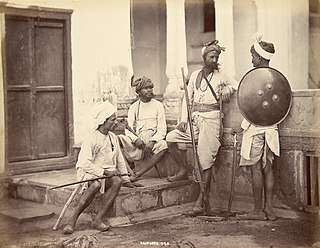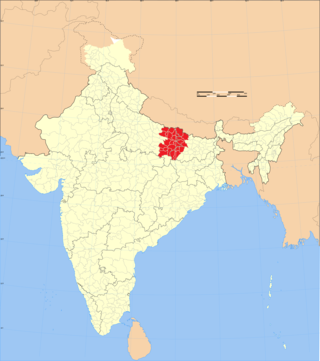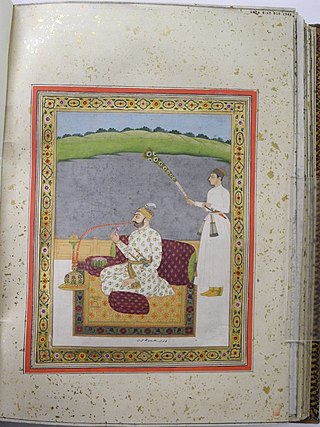Related Research Articles

Jauhar, sometimes spelled Jowhar or Juhar, was a Hindu practice of mass self-immolation by women, in the Indian subcontinent, to avoid capture, enslavement and rape by an invading army, when facing certain defeat during a war. Some reports of jauhar mention women committing self-immolation along with their children. This practice was historically observed in northwest regions of India, with most famous jauhars in recorded history occurring during wars between Hindu Rajput kingdoms in Rajasthan and the opposing Muslim armies. However jauhar is performed during war, usually when there was no chance of victory. The practice was accompanied by saka, or a last stand in battle.

Rajput is a large multi-component cluster of castes, kin bodies, and local groups, sharing social status and ideology of genealogical descent originating from the Indian subcontinent. The term Rajput covers various patrilineal clans historically associated with warriorhood: several clans claim Rajput status, although not all claims are universally accepted. According to modern scholars, almost all Rajput clans originated from peasant or pastoral communities.

Sher Shah Suri (1472, or 1486 – 22 May 1545), born Farīd Khān , was the founder of the Sur Empire in India, with its capital in Sasaram in modern-day Bihar. He standardized the silver coin to the weight of 178 grams and named the currency as rupee based on the ancient Sanskrit term for silver. An ethnic Afghan ruler, Sher Shah took control of the Mughal Empire in 1540 CE. After his accidental death in 1545 CE, his son Islam Shah became his successor.

Panipat is a historic city in Haryana, India. It is 95 km north of Delhi and 169 km south of Chandigarh on NH-1. The three major battles fought in 1526, 1556 and 1761 took place near the city. The city is famous in India as the "City of Weavers" and "Textile City". It is also known as the "cast-off capital" due to being "the global centre for recycling textiles". Panipat is included in the list of Critically Polluted Industrial area in India. The Comprehensive Environment Pollution Index (CEPI) of the city is 71.91 as against 88.50 of Ankaleshwar (Gujarat). The fatal field of Panipat is the site of three battles that changed the course of India's history, resulting in the creation and confirmation of the Mughal Empire, as well as the decisive defeat of the Maratha Confederacy in North India.
Tomar is a clan, some members of which ruled parts of North India at different times. People belonging to the Tomara clan are found among the Rajputs of Northern India.
Raja Shiladitya, also called Silhadi Tomar, was a Ror chieftain of northeast Malwa in the early decades of 16th century India. He recruited Sanga of Mewar as an ally and Sanga helped him and Medini Rai in various battles and in conquering Malwa from Sultans. He joined the Rajput Confederacy with garrison of 30,000 Rajputs at the Battle of Khanwa which was fought for supremacy of Northern India between Rajputs and Mughals.
Muslim Rajputs are the descendants of Rajputs in the northern regions of the Indian subcontinent who are followers of Islam. They converted from Hinduism to Islam from the medieval period onwards, retaining Hindu surnames such as Rana and Chauhan. Today, Muslim Rajputs can be found in present-day Northern India and Pakistan. They are further divided into different clans.
Kayamkhani or Kaimkhani is a Muslim community of India who were notable for ruling the Fatehpur-Jhunjhunu region in Rajasthan from the 1300s to the 1700s.

The Bhojpuri region or Bhojpur is an area encompassing parts of the Indian states of Bihar, Uttar Pradesh, and Jharkhand, and the Madhesh, Gandaki and Lumbini provinces of Nepal, where the Bhojpuri language is spoken as a mother tongue.
The Ujjainiya Parmār are a Rajput clan that inhabits the state of Bihar.

Nawab Sayyid Hassan Ali Khan Barha, also known as Qutub-ul-Mulk, Nawab Sayyid Mian II, Abdullah Khan II, was one of the Sayyid Brothers, and a key figure in the Mughal Empire under Farrukhsiyar.

Rajput resistance to Muslim conquests or Rajput opposition to Islamic invasions was a series of military resistance by several ruling Rajput houses of northern and western India against the Arab Caliphate invasions from Middle East and Islamic invaders of Central Asia in Medieval India. Before the Muslim conquests in the Indian subcontinent, much of northern and western India was being ruled by Rajput dynasties, who were a collection of martial Hindu families. The Rajput kingdoms contended with the rising and expansionist empires of the Muslim world, be they Arabs, Persians, Sayyids, Turks, Pashtuns, or Mughals. The Rajputs held out against the Caliphates and Central Asian empires for several centuries.
Purbiya was a common term used in medieval India for Rajput led mercenaries and soldiers from the eastern Gangetic Plain - areas corresponding to present-day western Bihar and eastern Uttar Pradesh. The Purbiyas played a significant role in the militaries of various principalities in Western India including the Marwar army.

Hemu's Smadhi Sthal, is a memorial to the Hindu king Hemu at Shodapur village on Jind road near Panipat city in Panipat district of Haryana state in India. It stands at the location where he was executed.

Shodapur is a village in Panipat district of the Haryana state in India. The Second Battle of Panipat was fought on 5 November 1556 between the forces of Akbar and Hemu, a Hindu king of Delhi. In the battle, a wounded Hemu was captured by Shah Quli Khan and carried to the Mughal camp at Shodapur on Jind Road at Panipat where he was beheaded.

Nawab Sayyid Hussain Ali Khan Barha, officially Ihtisham-ul-Mulk, was a kingmaker of the later Mughal Period. Best known for ordering the death of the Emperor Farrukhsiyar largely in attempt to halt the numerous assaination attempts that the latter had ordered against him and his brother Abdullah Khan Barha. Hussain Ali Khan rose as a kingmaker in early 18th century India, when he was also the de jure ruler of Aurangabad, ruler of Ajmer by proxy and Subedar of the Deccan

The Jaunpur-Bhojpur war, refers to the conflict between the Jaunpur Sultanate and the Ujjainiya Rajput chiefs of the Bhojpur region of Bihar.
Modern historians agree that Rajputs consisted of a mix of various different social groups and different varnas. Rajputisation explains the process by which such diverse communities coalesced into the Rajput community.
Raja Puran Mal was a Rajput ruler of Chanderi and Raisen, now in Madhya Pradesh, India, during the Mughal period and the Suri dynasty. He was the son of Raja Silhadi and princess of Mewar, Rani Durgavati.
References
- 1 2 3 4 5 Heilijgers-Seelen, Dory (ed.). "Kolff, Dirk Herbert Arnold". Dutch Studies on South Asia, Tibet and classical Southeast Asia. Netherlands. Retrieved 26 April 2021.
- ↑ Perlin, Frank (1993). The Invisible City: Monetary, Administrative, and Popular Infrastructures in Asia and Europe, 1500–1900. Variorum Reprints: Collected Studies Series, Volume 387 (illustrated ed.). Variorum (UK); Ashgate (USA). p. 72. ISBN 978-0860783428. LCCN 92036099. OCLC 1013427746.
With respect to «fictional» aspects of clan formation, see D.H.A. Kolff, An Armed Peasantry and its Allies: Rajput Tradition and State Formation in Hindustan, 1450–1850, 1983 (Doctoral thesis presented to the University of Leiden).
- 1 2 3 Heesterman, Jan C. (2004). Yoffee, Norman; Hagen, Gottfried; Crowell, Brad (eds.). "The Social Dynamics of the Mughal Empire: A Brief Introduction". Journal of the Economic and Social History of the Orient. Leiden, Netherlands: Brill. 47 (3, Between the Flux and Facts of Indian History: Papers in Honor of Dirk Kolff): 292–297. JSTOR 25165051 .
- ↑ "Kolff D.H.A. | NIAS". Netherlands Institute for Advanced Study. Amsterdam, Netherlands. Retrieved 26 April 2021.
- ↑ Fisher, Michael H. (1 March 2007). "JOS GOMMANS and OM PRAKASH, (eds), Circumambulations in South Asian History: Essays in Honour of Dirk H.A. Kolff, Leiden: Brill, 2003, pp. 370". The Indian Economic and Social History Review . SAGE. 44 (1): 93–95. doi:10.1177/001946460604400105.
The earlier volume, Circumambulations in South Asian History, stands as a festschrift to the distinguished Dutch historian and Indologist Dirk H.A. Kolff, offered by many of his students and friends.
- ↑ Richards, John F. (2004). Yoffee, Norman; Hagen, Gottfried; Crowell, Brad (eds.). "Warriors and the State in Early Modern India". Journal of the Economic and Social History of the Orient. Leiden, Netherlands: Brill. 47 (3, Between the Flux and Facts of Indian History: Papers in Honor of Dirk Kolff): 390–400. JSTOR 25165054 .
- ↑ Cooper, Randolf G. S. (February 1992). Johnson, Gordon (ed.). "Reviewed Work: Naukar, Rajput and Sepoy: The Ethnohistory of the Military Labour Market in Hindustan, 1450–1850 by Dirk H. A. Kolff". Modern Asian Studies . Cambridge, UK; New York, USA; Victoria, Australia: Cambridge University Press. 26 (1): 206–208. JSTOR 312725 .
- ↑ Wainwright, A. Martin (1992). Sinor, Denis (ed.). "Reviewed Work: "Naukar", Rajput and Sepoy: The Ethnohistory of the Military Labour Market in Hindustan, 1450-1850 by Dirk H. A. Kolff". Journal of Asian History. Wiesbaden, Germany: Harrassowitz Verlag. 26 (1): 86–88. JSTOR 41930846 .